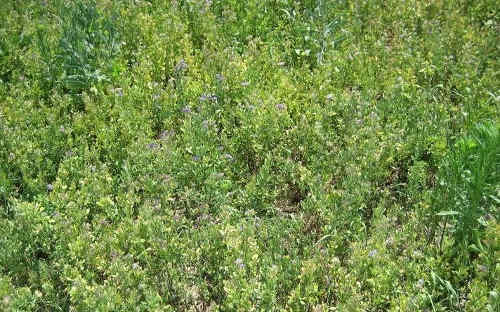By John Tooker
Potato leafhoppers are perennially the most damaging pest of alfalfa in Pennsylvania, but they can also cause economic damage in other legume forages and some vegetable crops. Their feeding reduces yield and quality (especially lower protein content), and can decrease stand longevity.
Potato leafhoppers (Figure 1) do not live in Pennsylvania all year, but migrate here each spring on storm fronts, arriving in late May and early June. Potato leafhoppers can be frustrating due to the sporadic nature of their infestations—even in bad leafhopper years, many fields escape damage. Once potato leafhoppers colonize alfalfa fields, adults deposit eggs into stems and leaf veins. In warm weather, these eggs will develop into adults in about three weeks, so populations can increase quickly. Potato leafhoppers have straw like mouthparts and extract plant juices. Heavy feeding disrupts nutrient flow within plants, causing yellow triangles to form at the leaflet tips ("hopper burn"), but this evidence of damage does not develop until 7-10 days after feeding begins. As feeding continues, damage gets worse (Figure 2) and the chlorotic areas spread toward the base of the leaflet. Once hopper burn is evident, economic loss has occurred.

Figure 2. Heavy potato leafhopper damage in alfalfa (Photo by Bryan Jensen, University of Wisconsin, Bugwood.org)
For non-chemical controls, resistant varieties of alfalfa are valuable. These varieties are covered with fine hairs (the hairs are actually “glandular trichomes”), which decrease leafhopper feeding, but obviously this option needs to be pursued before establishment. Another option is to mix other forages in with alfalfa. Alfalfa/orchardgrass stands (or other combinations) appear much better at tolerating leafhopper damage than pure stands of alfalfa. Spiders and other natural enemies kill potato leafhoppers, so using integrated pest management (IPM) and spraying insecticides only when economic populations develop will help maintain these allies in pest control. In fact, we have growers in Pennsylvania who do not treat their alfalfa fields with insecticides and claim they do not see potato leaf hopper damage; natural enemies would be the best explanation for this lack of damage.
If damaging populations develop, early harvest or insecticides are often the only choices. Early harvest can stop damage, but regrowth should also be scouted to determine if the next cutting also develops damaging populations. To target leafhoppers most effectively, populations should be sampled and treatment applied only when economic thresholds are exceeded. In my experience, regular scouting and use of economic threshold can limit the need to insecticides to once a summer. In most years, it makes the most sense to start sampling in the first week of June and continue to do so periodically. Scouting details and economic thresholds can be found in our
potato leaf hopper fact sheet .